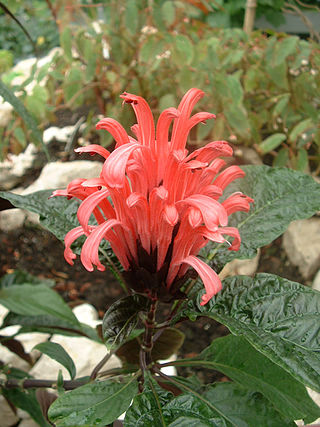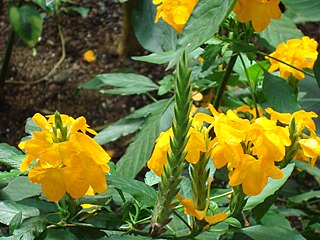
Acanthaceae is a family of dicotyledonous flowering plants containing almost 250 genera and about 2500 species. Most are tropical herbs, shrubs, or twining vines; some are epiphytes. Only a few species are distributed in temperate regions. The four main centres of distribution are Indonesia and Malaysia, Africa, Brazil, and Central America. Representatives of the family can be found in nearly every habitat, including dense or open forests, scrublands, wet fields and valleys, sea coast and marine areas, swamps, and mangrove forests.

Justicia is a genus of flowering plants in the family Acanthaceae. It is the largest genus within the family, encompassing around 700 species with hundreds more as yet unresolved. They are native to tropical to warm temperate regions of the Americas, India, and Africa. The genus serves as host to many butterfly species, such as Anartia fatima. Common names include water-willow and shrimp plant, the latter from the inflorescences, which resemble a shrimp in some species. The generic name honours Scottish horticulturist James Justice (1698–1763). They are closely related to Pachystachys.
Acanthopale is a plant genus of shrubs or subshrubs in the Acanthaceae plant family. The genus name is based on the classic Greek words for thorn ákantha and stake palum. Some species in the genus are cultivated as ornamental plants.

Anisotes is a genus of Afrotropical plants in the family Acanthaceae. The genus is morphologically similar to Metarungia, from which it differs mainly in the dehiscence of the fruit capsule, and the nature of the placenta. Placentas remain attached to the inner surface of fruit capsules in Anisotes.

Brachystephanus is a genus of flowering plants in the family Acanthaceae. It includes 21 species native to tropical Africa and Madagascar.

Brillantaisia is a genus of plants in the family Acanthaceae. They are native to the African tropics and subtropics, including Madagascar. They may grow from 20 cm to 2 m in height. Their hirsute stems are square in cross-section and their heart-shaped leaves have an opposite arrangement. Their purple or white pea-like flowers produce long, cigar-shaped seed pods. They reproduce easily from seeds or vegetatively. One species, B. lamium, is invasive in Queensland.

Isoglossa is a genus of flowering plants in the family Acanthaceae. It includes 78 species native to tropical Africa, Yemen, the eastern Himalayas, southern China, Indochina, Peninsular Malaysia, Java, Sulawesi, the Lesser Sunda Islands, and New South Wales.

Stenostephanus is a genus of plants in the family Acanthaceae. It includes 94 species native to the tropical Americas, ranging from northeastern Mexico to Bolivia and southeastern Brazil.

Crossandra is a genus of plants in the family Acanthaceae, comprising 54 species that occur in Africa, Madagascar, Arabia and the Indian subcontinent. Some species, especially Crossandra infundibuliformis, are cultivated for their brightly colored flowers.

Symphyotrichum oolentangiense, commonly known as skyblue aster and azure aster, is a species of flowering plant in the family Asteraceae native to eastern North America.
Xantheranthemum, known as the golden vein plant or bronze vein plant, is a genus of flowering plants in the family Acanthaceae. It has only one currently accepted species, Xantheranthemum igneum, native to Peru. It is grown as a greenhouse or house plant. There may be some confusion caused by the names of the botanists Linden and Lindau, as some sources associate it with Aphelandra goodspeediiStandl. & F.A.Barkley, along with Chamaeranthemum igneumRegel, Eranthemum igneumLinden, Stenandrium igneum(Linden) André, Stenandrium pictumN.E.Br., and Xantheranthemum igneum(Linden) Lindau.
Ancistranthus harpochiloides is a species of flowering plant belonging to the family Acanthaceae. It is a subshrub endemic to Cuba. It is the sole species in genus Ancistranthus.
Cephalacanthus maculatus is a species of flowering plant belonging to the family Acanthaceae. It is a subshrub or shrub endemic to San Martín Region of Peru. It is the sole species in genus Cephalacanthus.
Chalarothyrsus amplexicaulis is a species of flowering plant belonging to the family Acanthaceae. It is a subshrub native to central and southwestern Mexico. It is the sole species in genus Chalarothyrsus.
Chlamydacanthus is a genus of flowering plants belonging to the family Acanthaceae.
Chlamydocardia is a genus of flowering plants belonging to the family Acanthaceae.
Jadunia is a genus of flowering plants belonging to the family Acanthaceae.
Duosperma is a genus of flowering plants belonging to the family Acanthaceae.
Heteradelphia is a genus of flowering plants belonging to the family Acanthaceae. It includes two species native to Guinea, Côte d'Ivoire, and Nigeria in western tropical Africa and to São Tomé in the Gulf of Guinea Islands.
Megalochlamys is a genus of flowering plants belonging to the family Acanthaceae.








